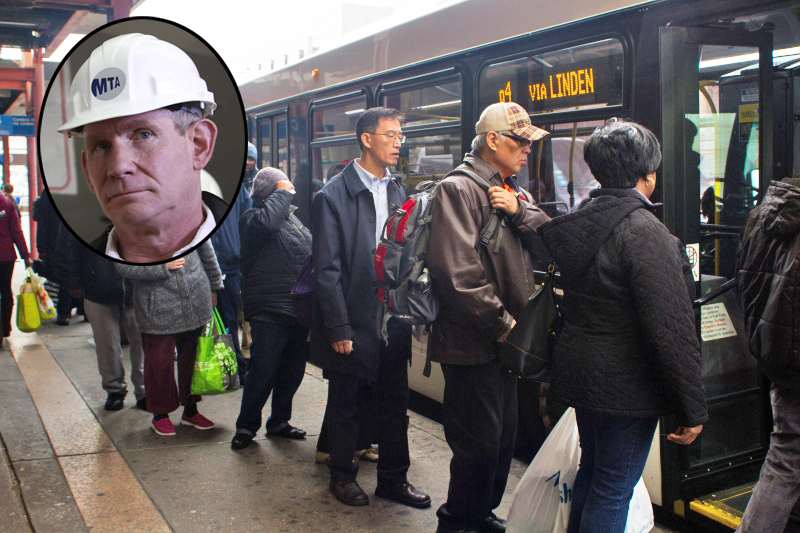The MTA's boss said on Wednesday that the agency's modest pilot program to test all-door bus boarding on a handful of routes was going back to the drawing board, with no plans for when it might see the light of day.
"I'm trying to rethink when would be the right time to do it," Chairman and CEO Janno Lieber said at the agency's monthly board meeting, adding that he claims the pilot will still happen and that the agency is still fully committed to eventually bringing back door boarding to MTA buses.
But Lieber also said that the pilot will have to wait until more bus riders are comfortable using the tap-and-go OMNY fare payment system. Currently, Lieber said under 20 percent of bus riders use OMNY (which is only on the back doors of SBS buses), and the OMNY system doesn't accommodate riders who rely on reduced or senior fare MetroCards, Fair Fares cards or student MetroCards.
"I wouldn't say it's not happening," Lieber said. "I think we need to think about how do we get there and do it in a real way that makes it possible for everybody to use the back door because their fare payment options will be available."
In August 2021, the MTA announced that it was planning a pilot of the boarding method in on 10 bus routes. But by this February, the agency said that it was still considering which 10 routes would be part of the study. Lieber's comments then, are the latest and most explicit setback for the attempt to bring (legal) back door boarding to local and limited buses in the city.
Longtime advocates for all-door boarding said the latest setback fits with history.
"It's disappointing to us," said TransitCenter Executive Director David Bragdon. "Janno's full-throated support is encouraging, but, historically the MTA is slow to embrace ideas from other places in general, and that includes this."
Transit advocates have been pressing the MTA to embrace all-door boarding since the Bus Turnaround Coalition brought up the idea in 2016, emphasizing the fare payment method as a way to speed up buses by reducing the amount of time they spend waiting for passengers to board through one door. The MTA has some experience with letting riders board through the back door through the use off-board payment on Select Bus Service routes across the city, which has helped reduce dwell times as much as 40 percent on some routes.
But even as the agency planned for tap-and-go fare collection that would allow the city to catch up to backwaters like San Francisco and London, MTA leadership pushed off the possibility of instituting all-door boarding systemwide. In 2019, OMNY project lead Al Putre said that he didn't foresee all-door boarding being instituted until 2021, when every bus could be equipped with OMNY readers. Although the readers are installed on every bus in the system, SBS buses are the only routes where back door scanners are turned on.
Historically, and currently, the MTA has suggested that fare evasion fears are one of the reasons that the agency can't pull the trigger on systemwide all-door boarding or even a pilot. In 2016, then-New York City Transit Executive Vice President Craig Cipriano was worried about fare evasion if the agency instituted all-door boarding. On Tuesday, Cipriano, now the interim NYCT president, sang the same tune.
"One thing we really need to look at closely is the fare evasion, fare collection issue that we currently have," Cipriano said at the launch for the Queens Bus Network Redesign on Tuesday. "That's really where our focus is."
The MTA has in fact reported that even without all-door boarding, riders are using the back door of buses more and more, which is why fare evasion rates are 30 percent systemwide and as high as 50 percent of riders in the Bronx. Numbers like that recently prompting TWU Local 100 Vice-President JP Patafio to say that that agency should just make the buses free.
Bus advocates said that instead of relying on the fears of the past and present, the MTA needs to put more brain power into figuring out its future and how to get the best of out OMNY on the bus.
"Until everyone has access paying for rear-door boarding, it makes sense to hold off on the pilot program," said Lisa Daglian, the executive director of the Permanent Citizens Advisory Committee to the MTA. "It’s an unfortunate delay, but an understandable one and we hope to see a good, workable plan within the next six months, including a timeline for implementation. When it’s time to put it in motion, we want to be sure there are ... are no barriers to accessing OMNY."
The MetroCard isn't scheduled to go to the big trainyard in the sky until early 2024, but some advocates are concerned that riders might be waiting until at least that year to finally speed their rides with the new boarding and payment system. (Some riders are late adopters because of the failure of the MTA to sell the cards widely and others are resisting because of digital privacy issues.)
"The question is, what's the acceptable threshold of percentage of OMNY users that will enable them to do all-door boarding?" asked Tri-State Transportation Center Policy and Communications Manager Liam Blank. "The pilot should probably focus on bus routes that have a lot of OMNY users already. One of the primary goals of all-door boarding is to speed up bus service and attract new riders due to the improved efficiency, so if we have to first wait for the vast majority of riders to switch to OMNY, we might be waiting years for all-door boarding."






